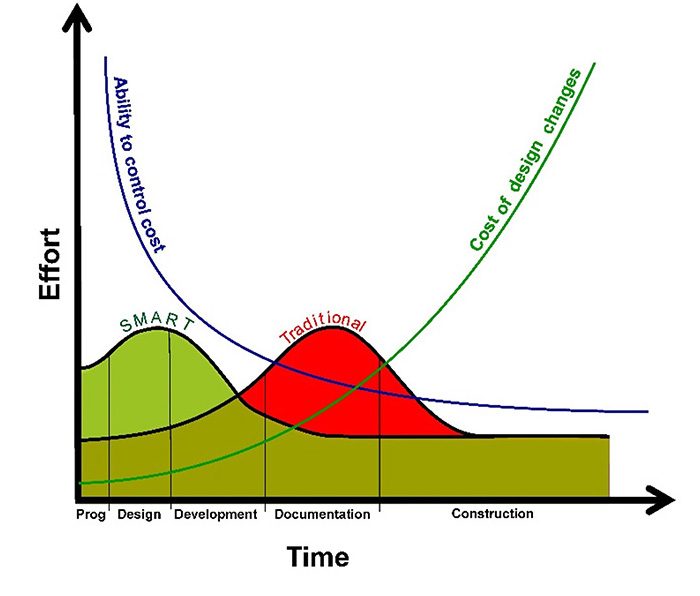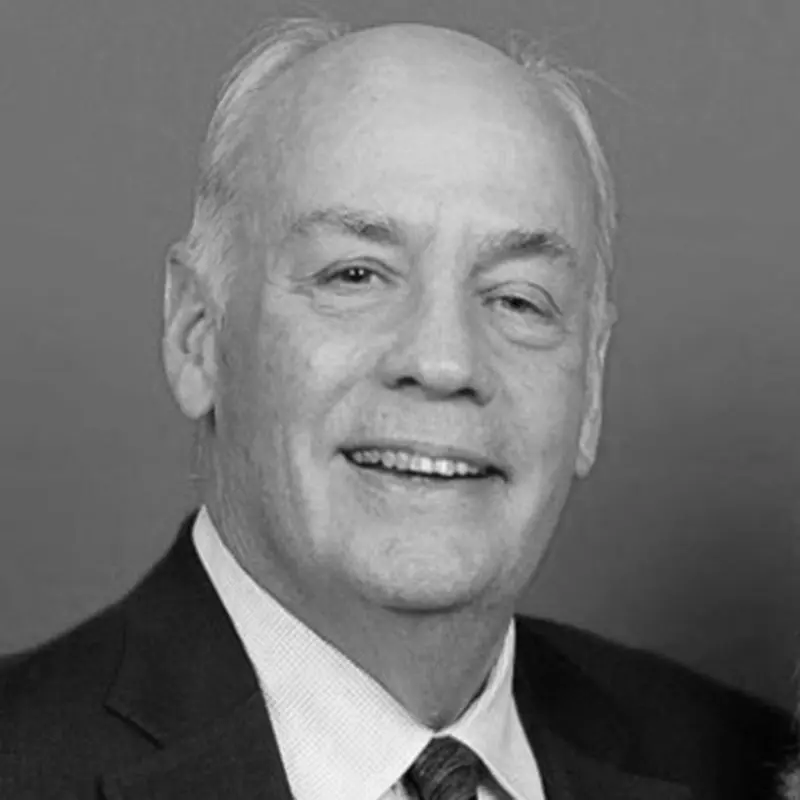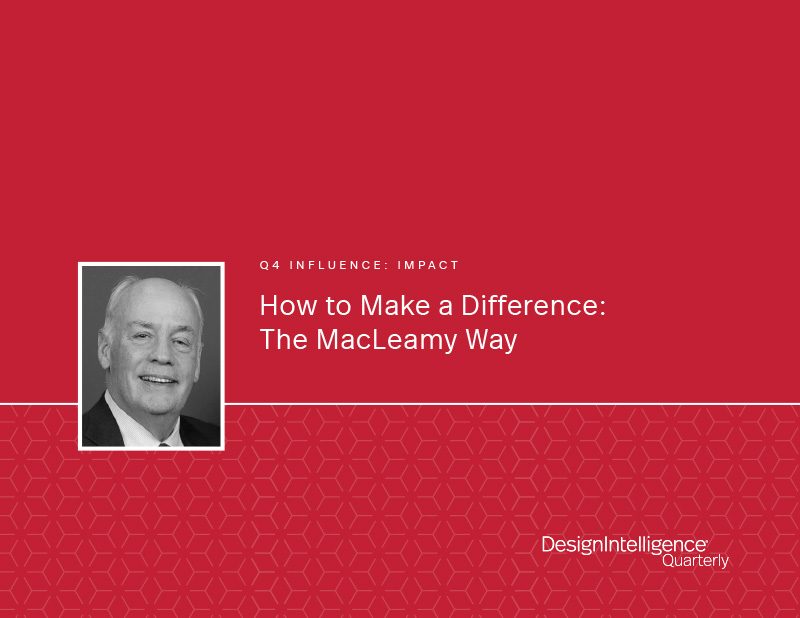How to Make a Difference: The MacLeamy Way
by Patrick MacLeamy
CEO Emeritus, HOK; Chairman, buildingSMART International
October 19, 2022
HOK’s CEO emeritus and buildingSMART International’s chairman discusses his new book and podcast and advises how architects can have greater impact through smart cities, shifted curves and open-source BIM.
DesignIntelligence (DI): Patrick, congratulations on your new book, “Designing a World-Class Architecture Firm,” and your podcast, “Build Smart.” I’d like to talk about both. But before we do, to frame the discussion, centered around our fourth-quarter theme of IMPACT under our 2022 editorial look at how we can increase the architects’ INFLUENCE, I’d like to level-set readers with an understanding of where you’re coming from. As someone who has experienced huge impact and results — leading a global design firm, in HOK, and chairing buildingSMART International (bSI), another global movement — it would help to know a bit more about your journey. What choices did you make on your developmental path to position yourself for such impactful roles?
Patrick MacLeamy (PM): My grandfather was a carpenter who built and sold individual houses for a living. He taught me how to draw house plans and I became hooked on design. My first exposure to architecture was at a high school career day. I reached out to the architect who did the presentation and asked if he could tell me more about the profession. He said he didn’t have time for me. I vowed then to not be like that if I were ever in his position.
I got my architecture degrees from the University of Illinois. After college, a former classmate helped me get an interview at HOK in St. Louis. Gyo Obata (the “O” in HOK) hired me as a junior designer in the firm’s 150-person office. I demonstrated project-management aptitude, and HOK encouraged me to focus on management operations instead of design. The upshot is that I opened HOK’s first-ever satellite office in 1970, in San Francisco. I joined the firm’s executive committee 25 years later, was elevated to COO in 2000 and served as CEO from 2003-2016, retiring 50 years to the day after I joined HOK. During that time, the firm grew to almost 2,000 employees, distributed among 27 offices on three continents.
Two pivotal decisions were my choice to pursue management operations instead of design and agreeing to attend what I call “charm school,” executive training that taught me how to really listen to coworkers and clients.
DI: That’s helpful in understanding your background better. How did you get involved with buildingSMART?
PM: Midway through my HOK career, I cofounded what became buildingSMART International because I was frustrated with our inability to coordinate utilities in the plenum — the spaces between the ceilings and the floors above in our projects. What started as a modest goal to coordinate geometry gradually became something much bigger — in fact, the biggest thing I have ever been involved with. The bigger buildingSMART’s impact becomes, the more we see ways to improve the building industry and liberate the architect to return to being a pillar in our society.
DI: Beyond buildingSMART, where else are you making a difference?
PM: I serve on my local design review commission, which gives me the opportunity to remain in touch with architecture. My wife and I recently formed a nonprofit organization to support improvements in our neighborhood. We also founded an organization called the Tree Team, with the goal of planting 10,000 new trees in our suburban city.
DI: Were you a longtime aspirant to having large-scale change, or is it something that presented itself along the way that you saw as an opportunity?
PM: I was not focused on having a big impact at the beginning of my career at HOK or at the start of buildingSMART. The possibility of having a big impact came with the steady growth of HOK from a regional to a national, then international, design firm. buildingSMART began with a simple basic problem: how to coordinate all the mechanical, electrical and plumbing in the plenum. This grew into a much larger mission: how to improve the global building and infrastructure industries through massive reinvention. As HOK and buildingSMART grew, we became aware of the importance of our role and its impact. That awareness and responsibility were huge incentives to continue.

DI: Impact can be thought of as being demonstrable and measurable. To what degree are those ways of thinking essential to your way of working and bringing about change? Your book talks about the importance of financial metrics. What leading indicators did you track at HOK and how often? Were there any counterintuitive or contrarian ones?
PM: When I became COO, most of HOK’s financial metrics were intelligible to CPAs but not to the rest of the employee-owned firm. Cash flow issues at the time added to the challenge. We simplified the metrics so architects could easily understand their offices’ profitability. One example is the “50 Percent Rule”: An office’s total annual salaries can’t exceed half its annual fees. Next was the “90-Day Rule”: Fees not billed and collected in 90 days are considered “unearned.” This affected bonuses and incentivized offices to improve cashflow.
Another important metric was the “10-Month Rule”: Every office needed to maintain a 10-month backlog of work to sustain its current size. Our challenge was identifying the right information, then sharing it so that everyone could see how their offices’ performance stacked up.
DI: Architects are notoriously “numbers averse” and tend to be loose when it comes to metrics, when compared to the rest of the business world. Any tips for how to motivate design leaders to become more measurement and results focused? Beyond that, how to reengineer their values to become entrepreneurs and risk managers that seek the greatest impact and model their behavior to achieve it? So many of us are still content to play in our sandbox and let the chips fall where they may.
PM: HOK cofounder George Hellmuth grew up with a father and an uncle who were architects. He watched their firm hire drafters when they had work, only to lay them off between projects. Hellmuth’s dad didn’t have enough work to hire his own son out of college. To counter these cycles, and rooted in architects designing the projects they brought in, Hellmuth designed HOK to include specialized leaders: Gyo Obata headed design, George Kassabaum led operations and Hellmuth was possibly the industry’s first full-time marketer. He was also one of the first to realize a firm’s people were its greatest asset. Investing in training people only to lay them off and drive them to competitors just wasn’t — and still isn’t — smart business.
Architects learn design, but most university professional practice courses don’t teach the realities of designing a successful business. Like almost all architects, I wanted to design buildings. HOK convinced me that a career path in operations offered more opportunities for my skills. The motivation for my book, “Designing a World-Class Architecture Firm: The People, Stories, and Strategies Behind HOK,” was to share the firm’s experiences in overcoming recessions and other challenges. While it’s intended for working architects, I hope it will also help architecture students realize that the profession offers myriad career paths beyond building design.
DI: Same question for bSI. As a movement now decades old and simultaneously growing rampantly yet still nascent among all potential users, how do you set goals and measure progress in such evolving disciplines as technology, BIM and open data?
PM: You are correct that buildingSMART is 25 years old and just now becoming well known to owners, architects and builders. Why? As buildingSMART began to develop digital standards, our first focus was on the design phase and coordinating geometry.
Over the years we continued to move the goal posts, extending our standards from the design phase to construction and then building operations. We also extended the standards from geometry to everything else needed for modern buildings — a very long list.
DI: I’d be remiss if I didn’t ask you about one of your most well-known industry contributions: the so-called MacLeamy Curve or Effort Curve. It posits that information must be moved earlier in the design phases to add value. I’ve been to and presented at hundreds of BIM conferences over the past 20 years, and your curve has been shown or referenced in every single one of them! Can you explain it?
PM: The premise behind the Effort Curve (which became known as the MacLeamy Curve) is that costs are easiest to control early in the process. Once a project is under construction, changes become exponentially more expensive than they are in the design stage.
DI: I’m going to challenge your premise. While I agree we need to move data forward, I disagree that we need to move all of it. Projects that require modelers to complete door hardware schedules in schematic design burden the design team with an undue load at a time when owners, developers and contractors don’t want to commit to higher upfront fees until project feasibility has been validated. I’m assuming you agree with my challenge in your describing the shifting the curve to the left as “optimizing it.” I argue we should only shift selected key aspects upfront, perhaps using the Pareto Principle, or 80/20 rule, to identify the most impactful and necessary design intent knowledge bits ... and save the rest of the decisions until we need them. Am I rocking your world — or are we aligned? Let’s have it out. Let’s throw down the gloves.
PM: My approach was to move effort forward in time in the process, avoiding corrective actions, which are always more expensive the later they come. Your challenge is about moving data forward. I believe architects can make more informed design decisions using selective data, for example, to design deep-green buildings.

MacLeamy Curve 2003
The MacLeamy Curve still contains design development and documentation, but I anticipate much less effort for these phases with the help of a thorough design phase supported by ever-smarter software.
We are in agreement that there is a time for everything, and the 80/20 rule still prevails — as long as the designer is thoughtful about which data will help achieve project goals.
DI: Your role in the Smart Cities movement is intriguing. I find the term still fuzzy and mysterious. It offers a buzzword for greater impact and influence, but what does it mean?
PM: buildingSMART has a formal collaboration agreement with the Open Geospatial Consortium (OGC), the standards body for GIS software, and the International Standards Organization (ISO) to assure that all information is available to designers who work at the large scale of cities or regions.
I want to encourage architects to think bigger than one building at a time. Great cities need great design thinking and big ideas. Architects are uniquely qualified to work in this way and more qualified to design cities or great parts of cities than city planners or civil engineers — who are currently responsible for most urban planning.
Think about airports as microcosms of cities, with their own transportation infrastructure (often public trains or buses that get people to and from the airport), full-time police forces and on-site health care provisions. Architects design airports; why not cities?
DI: How are the buildingSMART efforts for common data, the Internet of Things and GIS connected to smart cities? How can architects leverage that to create more value for owners and themselves?

PM: One way is the link between GIS and BIM described above. My entire purpose in founding buildingSMART — and the strategy behind the MacLeamy Curve — is to restore design as the primary focus for architects, by reducing repetitive, tedious coordination work. Every architect I know went to school to design — not to coordinate!
DI: Is there a strategy for ways to leverage all these things you’ve described to transform architectural design (and other) services from being a commodity to being as highly valued as its potential suggests it should be? How can we make a difference?
PM: Yes! buildingSMART and the MacLeamy Curve are all about liberating the architect to focus on design again, to provide noble places for people all over the world.
DI: Your book was largely a retrospective about the HOK experience and challenges overcome. Shift your gaze forward. What should the next HOK-like firm be doing now to create a similar successful growth trajectory — one that will likely be markedly different from HOK’s?
PM: Looking ahead, I believe successful architecture practices will be focused on design. I do not mean fashion, the latest trends or superficial appearance. Rather, design should be lovingly considered, of high quality and with a light touch on our environment.
DI: As a fellow boomer, I’m impressed at your ability to reinvent yourself in your current evolution as author and podcaster and evolve and adapt to new media forms. How are you enjoying it as compared to running a massive firm?
PM: I am loving what I do today! I am busy, productive and working hard ... but not for money. I am just finishing a new season of the “Build Smart” podcast based on the founding and growth of buildingSMART and am beginning work on a new book. That and being an active husband, father and grandfather give me a very full and happy life.
DI: Any last thoughts?
PM: You have presented me with some of the most incisive and provocative questions. I have enjoyed this discussion very much. I hope our readers feel the same way.
Patrick MacLeamy, FAIA, LEEP AP, spent 50 years at HOK, during which time it grew from 150 people in a St. Louis office to nearly 2,000 employees in 27 offices on three continents. He joined HOK St. Louis in 1967, rising to CEO during the 13 years preceding his retirement. MacLeamy helped the firm assume a global leadership role in sustainability; HOK published the first edition of its “Guidebook to Sustainable Practices” in 2000. MacLeamy has served the industry in many roles and received multiple honors. He was a member of the Architecture and Engineering Productivity Committee of the GSA’s Construction Users Round Table, chaired the Construction Industry Round Table, served on the American Institute of Architects’ Large Firm Roundtable, is a member of the National Academy of Construction, was honored with the National Institute for Building Sciences President’s Award and was named an AIA Fellow. He currently leads buildingSMART International, an organization working to achieve open BIM standards to improve sustainable design for the building and infrastructure industries. MacLeamy’s book, “Designing a World-Class Architecture Firm: The People, Stories, and Strategies Behind HOK” (Wiley, 2020), relays practical recession survival tips for services-related firms. His new podcast series, “Build Smart,” is based on this book.


